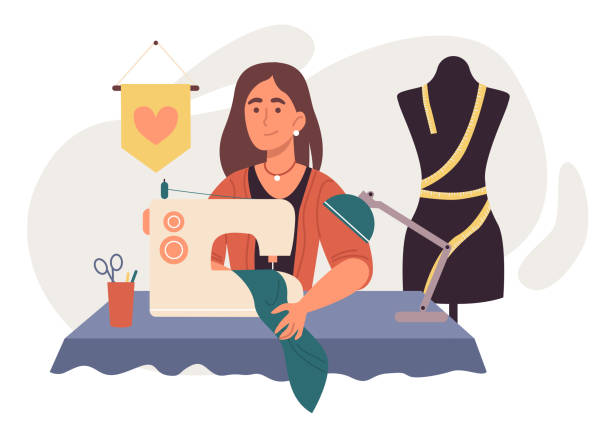
مقدمه
در دنیای امروز، یادگیری مهارتهای عملی مثل آموزش دوخت لباس نه تنها میتواند منجر به خودکفایی شود، بلکه فرصتی عالی برای کسب درآمد و ورود به صنعت مد و پوشاک نیز فراهم میآورد. خیاطی، ترکیبی از هنر، دقت، و سلیقه است که با کمی تمرین و پشتکار، هر کسی میتواند آن را بیاموزد.
چرا آموزش دوخت لباس اهمیت دارد؟
با رشد قیمت پوشاک، تمایل افراد به یادگیری خیاطی و دوخت لباس بیشتر شده است. از طرفی، توانایی دوختن لباسهایی مطابق با اندازه و سلیقه شخصی، تجربهای لذتبخش است. این مهارت به شما اجازه میدهد لباسهایی منحصربهفرد طراحی کرده و حتی آنها را در فضای آنلاین یا فروشگاههای محلی به فروش برسانید.
مراحل شروع یادگیری دوخت لباس
یادگیری دوخت لباس نیازمند آشنایی با چند مرحله مهم است. در ادامه مراحل کلیدی آموزش خیاطی را بررسی میکنیم:
۱. شناخت ابزار و وسایل خیاطی
در ابتدای مسیر، باید با ابزارهای اصلی خیاطی آشنا شوید:
- چرخ خیاطی
- سوزن، نخ، متر و قیچی
- نوار اندازهگیری
- الگوهای خیاطی
- کاربن خیاطی و صابون خیاطی
۲. آشنایی با انواع پارچهها
هر پارچه ویژگی خاص خود را دارد. شناخت جنس، ضخامت و نحوه برش هر نوع پارچه یکی از مهمترین بخشهای آموزش خیاطی است. برخی از پارچههای پرکاربرد عبارتاند از:
- نخی (مناسب برای مبتدیها)
- لینن
- کرپ
- ژرسه
- ساتن
- حریر
۳. یادگیری الگوکشی
در این مرحله، نحوه کشیدن الگو روی کاغذ و سپس انتقال آن به پارچه آموزش داده میشود. الگوکشی، پایهی اصلی خیاطی حرفهای است و باید با دقت فرا گرفته شود.
۴. برش پارچه
با استفاده از الگو، پارچه برش زده میشود. دقت در این مرحله تضمین میکند که لباس نهایی به درستی روی بدن بنشیند.
۵. دوخت و سرهمبندی
دوختن قطعات پارچه به یکدیگر مرحله نهایی است. در این بخش، با تکنیکهای مختلف دوخت مانند دوخت ساده، زیگزاگ، پاکدوزی و دوخت مخفی آشنا میشوید.
دورههای آموزش دوخت لباس برای مبتدیها
برای کسانی که هیچ تجربهای در خیاطی ندارند، پیشنهاد میشود از دورههای آموزش دوخت لباس مبتدی شروع کنند. در این دورهها معمولاً آموزش دوخت لباسهای ساده مانند:
- دامن راسته
- مانتو آزاد
- شلوار راحتی
- بلوز ساده
آموزش داده میشود و به مرور با تکنیکهای پیشرفتهتر نیز آشنا خواهید شد.
آموزش دوخت لباس بدون الگو
برخی از طراحان و خیاطان حرفهای، لباسهایی را بدون استفاده از الگو میدوزند. این روش برای طراحی لباسهای آزاد و مدرن بسیار کاربرد دارد، اما نیاز به تجربه، شناخت دقیق بدن و توانایی برش دقیق دارد.
دوخت صنعتی در مقابل دوخت خانگی
در آموزش دوخت لباس، باید تفاوت بین دوخت صنعتی و دوخت خانگی را در نظر گرفت. دوخت صنعتی بیشتر برای تولید انبوه در کارگاهها استفاده میشود و نیازمند ماشینآلات حرفهایتر است. اما دوخت خانگی با چرخهای سادهتر و تمرکز بر کیفیت و جزئیات انجام میشود.
چگونه در دوخت لباس پیشرفت کنیم؟
- تمرین مداوم
- تماشای ویدیوهای آموزشی
- شرکت در کارگاههای حضوری یا آنلاین
- استفاده از الگوهای آماده
- مطالعه کتابها و مجلات خیاطی
جمعبندی
آموزش دوخت لباس یکی از مفیدترین مهارتهایی است که هر فرد میتواند در زندگی خود یاد بگیرد. این هنر نه تنها میتواند جنبهی شخصی و هنری داشته باشد، بلکه با کمی خلاقیت میتواند به شغل و منبع درآمدی پایدار تبدیل شود. با ورود به دنیای خیاطی، دنیای جدیدی از رنگ، طرح و سبک به روی شما گشوده خواهد شد.
✅ کلمات کلیدی :
آموزش دوخت لباس، خیاطی، الگوکشی، پارچهشناسی، دوخت مانتو، دوخت دامن، خیاطی بدون الگو، دوره آموزش خیاطی، ابزار خیاطی، آموزش خیاطی از پایه
Learn How to Sew Clothes: A Practical and Creative Skill for Everyone
Introduction
In today’s fast-paced world, acquiring practical skills like learning how to sew clothes offers both personal satisfaction and professional opportunities. Sewing is more than just stitching fabric; it’s a creative, calming, and empowering craft that allows you to express your style and even build a sustainable business.
Why Learning to Sew Clothes Matters
Whether you want to make your own clothing, save money, or start a fashion brand, learning how to sew gives you full control over your wardrobe. You can design garments that fit perfectly, match your personality, and meet your ethical values. With growing interest in slow fashion and handmade clothing, sewing is making a major comeback.
How to Start Learning How to Sew Clothes
Sewing can seem overwhelming at first, but breaking it down into steps makes it approachable. Here are the main stages every beginner should go through:
1. Get Familiar with Basic Sewing Tools
To start sewing, you’ll need:
- A sewing machine
- Needles and threads
- Measuring tape and scissors
- Pins and pin cushion
- Fabric marking tools (like chalk or washable pens)
- Sewing patterns (paper or digital)
2. Understand Different Types of Fabrics
Each fabric behaves differently when cut and sewn. Beginners are usually encouraged to start with stable fabrics like:
- Cotton
- Linen
- Denim
- Felt
- Broadcloth
Understanding fabric grain, stretch, and texture is essential for proper cutting and sewing.
3. Learn How to Read and Use Patterns
Sewing patterns serve as blueprints for your garments. They show where to cut, fold, and stitch. Learning how to interpret pattern markings and instructions is crucial for building your sewing confidence.
4. Cutting the Fabric
This step requires careful attention. Place the pattern on your fabric, follow grain lines, and cut precisely. A poorly cut piece will affect the fit and final look of your clothing.
5. Sewing and Finishing
Once cut, start stitching the pieces together using your sewing machine or hand stitching for small parts. Beginners should learn basic stitches like:
- Straight stitch
- Zigzag stitch
- Hemming
- Overlock stitch (if available)
Sewing Courses for Beginners
If you're just starting, consider enrolling in a beginner sewing course. These classes usually start with:
- Basic stitches and machine handling
- Sewing simple items like pillowcases or tote bags
- Progressing to garments like skirts, tops, or casual dresses
Both online platforms and local sewing studios offer structured programs that guide you step by step.
Learning to Sew Clothes Without Patterns
Some experienced sewers and designers choose to sew without traditional patterns. This method relies on body measurements and freehand cutting. It's great for loose, flowy garments and creative experimentation, but it's not ideal for complete beginners.
Home Sewing vs. Industrial Sewing
Home sewing is tailored for custom, small-batch creations and focuses on detail and personalization. Industrial sewing, on the other hand, is used in mass production and requires specialized equipment. If you're starting as a hobbyist or small business owner, home sewing is the ideal entry point.
How to Improve Your Sewing Skills
- Practice regularly
- Watch video tutorials
- Join sewing communities (online or local)
- Use beginner-friendly patterns
- Experiment with new fabrics and techniques
The more you practice, the more comfortable and confident you’ll become.
Final Thoughts
Learning how to sew clothes is a valuable skill that blends creativity, self-sufficiency, and entrepreneurship. Whether you're crafting your first shirt or planning to launch a clothing line, sewing gives you the tools to bring your ideas to life. Start with simple projects, be patient with yourself, and enjoy the process of turning fabric into fashion.
✅ Keywords :
learn how to sew clothes, sewing for beginners, sewing course, sewing patterns, fabric types, basic sewing tools, how to sew a dress, home sewing vs industrial sewing, sewing skills













